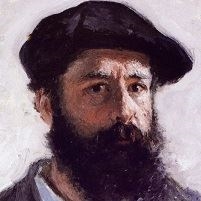 |
| Self Portrait of Claude Monet (http://www.biography.com/people/claude-monet-94117 (Claude Monet) |
"People discuss my art and pretend to understand as if it were necessary to understand, when it's simply necessary to love", Claude Monet once said. Monet's paintings mainly conveyed emotions by creating hazy strokes and fleeting impressions. Young Monet fell in love with painting oceans and rivers in his hometown, Le Havre. In the summer of 1862, he studied with artists Eugene Boudin and Johan-Barthold Jongkind, who taught him and influenced his works. As Monet pursued his art career, he faced many challenges both mentally and physically, causing his decline in motivation to become an artist. However, he rose above his adversities to become a founding father of the French Impressionist Revolution and created hundreds of valuable artworks, one being his striking waterlily painting, Decorations des Nympheas, that sold for millions. Because of his persistence in achieving his dreams and the originality of his artwork, Claude Monet fits the title of an inspirational hero.
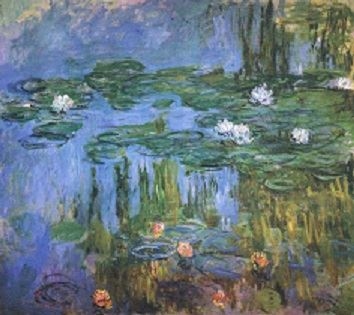 |
| Monet's Water Lilies ( https://www.guiaviajesa.com/pinturas-famosas/) |
Monet demonstrated perseverance through arduous hardships and depression. From an early age, Monet was determined to be an artist. On the other hand, "Monet's father and uncles were conservative businessmen who hated the arts and had little use for painters. They encouraged young Claude to ignore his artistic side and instead study business. However, Claude had an intense dislike of school, which he called prison" (Kallen 12). Monet had dreams of being an artist and often spent his time drawing instead of learning. Even though his family disapproved of his pursuits, Monet unceasingly followed his dreams rather than giving in and doing something that he detested. Without his father's support, Monet struggled financially to satisfy his daily needs. However, he overcame the obstacles that he faced and kept painting. In 1861, Monet gave up the chance to escape the draft so that he could persevere in his art career. His father, "Claude Adolphe offered to pay for Monet's discharge on the condition that he return to Le Havre and work in the family business. Monet refused and instead signed up for a five-year term in a glamorous cavalry division called Chasseurs d'Afrique, or Hunter of Africa" (Kallen 22). Although he had the chance to escape service, Monet refused to sacrifice his dream of becoming an artist. He not only declined his father's offer but also enlisted to serve for longer than what was required. Through this act, Monet showed his resolve to pursue his passions. Towards the end of his life, Monet suffered even more devastating challenges: He became increasingly withdrawn after the death of [his wife] Alice in 1911 and the death of his son Jean just three years later. In his final years, two eye operations for double cataracts only partially improved his failing eyesight as he devoted all his efforts to work. In light of his failing eyesight and true to his beliefs, Monet directed his lingering artistic abilities to a monumental series of panels--the Water Lilies series...Despite increasing fatigue and dejection, Monet continued to paint. ("Monet's Water Lilies") Monet's eyesight, which was more than important to him since he was a painter, started to fade as he aged. Along with his health problems, the deaths of his wives and children also devastated Monet. These events impacted in his life, but he did not give up on painting. Instead, he continued to create beautiful pieces of artwork, demonstrating his determination and persistence in achieving his goal. Monet faced countless obstacles throughout his art career, but persevered through them, making him inspirational.
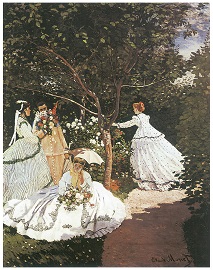 |
| Women in the Garden (https://fineartamerica.com/featured/1-women-in-the (Claude Monet) |
Monet also pioneered his distinct and original style of painting, Impressionism, despite the bitter criticism and painful rejection he received for his works. It was more difficult for him to display and sell his artwork because esteemed artists disliked them: "Behind this hostility was the challenge the impressionists made to the government-sanctioned Salons...The resulting paintings, critics charged, resembled rough sketches rather than carefully finished paintings" (Brown). Trained artists often rejected and criticized Monet's paintings because they were not realistic and precise. He, on the other hand, used blurred strokes to capture moving scenes with misty colors. Even though his art was not appreciated, he did not conform to the majority and instead painted the way he wanted to. Monet embraced who he was as a painter and created strikingly beautiful and original pieces of artwork. Vanessa Potts, an art exhibition judge, stated that Women in the Garden was an unworthy showcase because [t]his large size of canvas was traditionally reserved for historical or religious paintings that carried a moral message for the viewer. By painting an unremarkable modern scene, Monet was declaring that these everyday moments, painted in a realistic manner, were just as important in the art world as esteemed historical or religious subjects. (qtd. in Kallen 30-31) Monet did not paint in the manner of painters in his time period. He used massive canvases for subjects that society did not believe was important. Many of his works portrayed everyday people, nature, and whatever was in front of him. Monet's style was special and he did not let rejections by the exhibition change the way he painted. Instead, he continued to paint impressionistically. Through this, Monet demonstrates the importance of being original and going beyond the norm. Not only did he paint with different subjects, Monet also mainly painted his pieces outside: Whereas the Barbizon artists painted only preliminary sketches en plein air, Monet often worked directly on large-scale canvases out of doors, then reworked and completed them in his studio. His quest to capture nature more accurately also prompted him to reject European conventions governing composition, color, and perspective. (Auricchio) Monet preferred to spend his time outside to capture exactly the scene before him, unlike other artists who worked in a studio. He also demonstrated his objects in a different perspective and used colors differently than other Barbizon or European artists. Monet's distinctive and unique style was the beginning of the Impressionist era and paved a way for future artists.
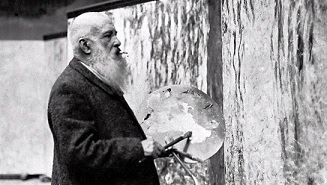 |
| Monet at Work (https://richardnilsen.com/2013/06/25/monet-at-give ()) |
Claude Monet is a deserving hero that inspires many people till this day. He created original artwork despite what other people thought, and was persistent in achieving his goals. Monet's value of his paintings climb up each year, which proves that success can appear after the most stormy night. "In June 2007 one of the artist's turn-of-of-the-century water lily paintings, Nympheas, sold for $36.5 million. At the same auction the 1904 canvas Waterloo Bridge, Overcast Weather sold for $35.5 million, nearly triple the presale estimated price" (Kallen 98). Even though Monet struggled through emotional, physical, and financial pains, his paintings are cherished and their success inspires people to keep pursuing their dreams no matter the circumstance. His art also inspired and started new types of art later on: Monet's influence on art of his period was profound. The development of abstract art can be seen as a direct consequence of his use of soft, gentle, non-defined patches of light leaving completion of the picture to the imagination of the viewer. The Pointillists used tiny dots of color to create their works. These usually appear indecipherable from close at hand, and only at a distance do they reveal their full impact...Cubism--represented by Pablo Picasso and Georges Braque--took the simplification of form even further, sometimes showing different views of the subjects that were split into cubes and planes. ("Monet's Water Lilies") Monet's Impressionism lead to several painting styles. His use of color and brushes inspired abstract painting, pointillism, and Cubism. Monet's work also influenced great artists such as Andre Derain, Pablo Picasso, and Georges Braque. His water lily paintings have additionally inspired my artwork as well. Recently, I created a painting that attempted to emulate the emotions that were in his. Monet has taught me that the feelings and messages that are conveyed in a piece of artwork are more important than its preciseness and perfection. After all, he intended for his art to be loved, not understood. Monet is an influential artist to many people and art styles because of his perseverance and uniqueness that radiates off his beloved works.
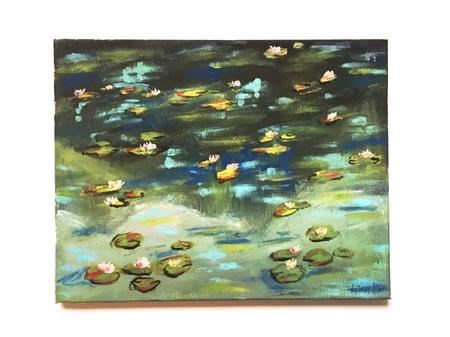 |
| Water Lilies by Sydney Hsieh |
Works Cited
Auricchio, Laura. "Claude Monet". The Met's Heilbrunn Timeline of Art History, 4 Oct. 2004,
www.metmuseum.org/toah/hd/cmon/hd_cmon.htm.
BROWN, ROBERT. "Claude Monet." Europe 1789-1914: Encyclopedia of the Age of Industry
and Empire, edited by John Merriman and Jay Winter, Charles Scribner's Sons, 2006.
Biography in Context, link.galegroup.com/apps/doc/K3446900553/BIC1?u=powa9245&
xid=63ec2b39. Accessed 28 Apr. 2017.
Kallen, Stuart. Claude Monet. Lucent Books, 2009.
"Monet's Water Lilies Are Shown at the Musée de L'Orangerie, May 17, 1927." Historic World
Events, Gale, 2012. Student Resources in Context, link.galegroup.com/apps/doc/BT2359
070296/SUIC?u=powa9245&xid=484bbd56. Accessed 1 May 2017.
Page created on 5/23/2017 12:00:00 AM
Last edited 5/23/2017 12:00:00 AM
